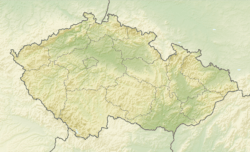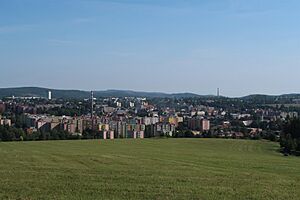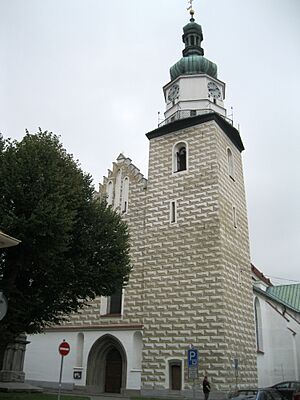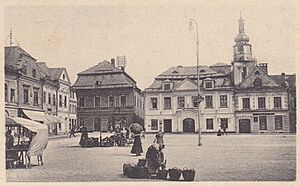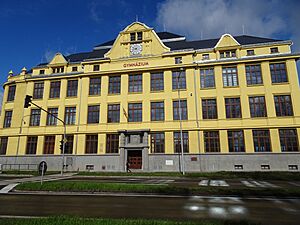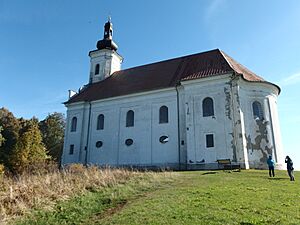Bruntál facts for kids
Quick facts for kids
Bruntál
|
|||
|---|---|---|---|
|
Town
|
|||
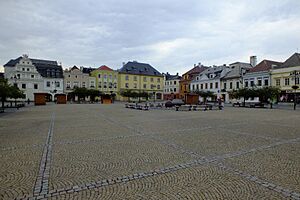
Míru Square
|
|||
|
|||
| Country | |||
| Region | Moravian-Silesian | ||
| District | Bruntál | ||
| First mentioned | 1223 | ||
| Area | |||
| • Total | 29.34 km2 (11.33 sq mi) | ||
| Elevation | 409 m (1,342 ft) | ||
| Population
(2024-01-01)
|
|||
| • Total | 15,244 | ||
| • Density | 519.56/km2 (1,345.66/sq mi) | ||
| Time zone | UTC+1 (CET) | ||
| • Summer (DST) | UTC+2 (CEST) | ||
| Postal code |
792 01
|
||
Bruntál is a town in the Moravian-Silesian Region of the Czech Republic. It is home to about 15,000 people. The old part of the town is very well kept. It is even protected by law as a special urban monument zone.
Contents
What's in a Name?
The original German name for Bruntál was Freudenthal. This means "valley of joy." It describes how the town sits in a valley. The Czech name, Bruntál, came from this German name.
Exploring Bruntál's Geography
Bruntál is located about 45 kilometers (28 miles) north of Olomouc. It is also about 55 kilometers (34 miles) northwest of Ostrava. The town is in the historical area of Czech Silesia. It sits within the Nízký Jeseník mountain range.
The town is in a valley, surrounded by several hills. The highest point nearby is Uhlířský vrch, which is 672 meters (2,205 feet) above sea level.
Several small creeks flow through Bruntál. These include the Černý Creek and its smaller branches. There is also a pond called Kobylí Pond right in the middle of town. Another pond, Bukový fish pond, is in the northern part.
A special part of Bruntál, called Karlovec, is located about 5 kilometers (3 miles) southeast of the town center. It sits by the Slezská Harta Reservoir.
Uhlířský vrch: A Young Volcano
Uhlířský vrch is a very interesting geological spot. It is a stratovolcano, which means it formed from both explosive eruptions and lava flows. It is made of different kinds of volcanic rocks. This volcano is one of the youngest extinct volcanoes in the Czech Republic.
A Look at Bruntál's History
Early Days: 13th–15th Centuries
The first time Bruntál was mentioned in writing was in 1223. This was in a special document called the Uničov Charter. King Ottokar I issued this charter. It is believed that Vladislaus Henry founded Bruntál around 1213. He also gave it special rights, known as Magdeburg rights.
Bruntál was the first place in the Czech lands to get these rights. Because of this, it became a very important court for other cities in Northern Moravia that also had Magdeburg rights. This lasted until 1352. The town was likely founded to dig for valuable ore and to stop others from settling the area.
Bruntál started as a mining town. Digging for precious metals and later iron was its main way to make money until the 1600s. This is why the town's coat of arms, from as early as 1287, shows a miner. Besides mining, the town also grew because it was on a trade route and had many skilled craftspeople.
Different rulers from the Přemyslid dynasty owned Bruntál for a long time, until 1474.
In 1474, during a war, the army of Matthias Corvinus took over Bruntál. He then gave the town to his supporter, Jan of Vrbno. Even though Jan of Vrbno only held the town as a promise, he started calling himself "of Vrbno and Bruntál" from 1476.
The 16th Century: Growth and Change
In 1506, Jan of Vrbno's sons bought the town and nearby villages and mines. This made Bruntál their own property. However, the Lords of Vrbno started taking away the town's special privileges. They also made people work for free and tried to force them to change their religion to Lutheranism. This led to a failed rebellion against Jan the Elder of Vrbno in 1556.
Even with these problems, Bruntál's economy did very well under the Lords of Vrbno. The town was allowed to hold several markets each year. Many new guilds (groups of skilled workers) also started.
More mining led to new towns being founded nearby. These included Andělská Hora around 1550 and Vrbno pod Pradědem in 1611. During the 1500s, Bruntál itself changed a lot. It was rebuilt in the beautiful Renaissance style and made stronger with new walls.
Later Centuries: 17th–19th Centuries
In 1621, the town was taken from Jan IV of Vrbno. This was because he was part of a rebellion. Bruntál was then given to the Teutonic Order. In the years that followed, people were forced to become Catholic again. During the Thirty Years' War, the town was attacked and damaged many times. It also suffered from a big fire in 1643 and terrible sicknesses in 1633 and 1647. Bruntál slowly recovered, but it never became as important or rich as it once was.
The 1700s brought more challenges, like sicknesses in 1714 and 1739, and large fires in 1748 and 1764. Still, many beautiful new Baroque buildings were built. A new post office also opened in 1748.
In the 1800s, the Industrial Revolution began. From 1823 to 1826, the old town walls were taken down. New public buildings were built, and many textile factories opened. Bruntál became a major center for the textile industry in Czech Silesia. The railway came to town in 1872.
20th Century Changes
In 1910, most of Bruntál's 8,066 people spoke German. After World War I, Bruntál became part of the new country of Czechoslovakia. This caused some unrest among the German-speaking people. More Czech families moved to the town, forming a growing group.
German nationalism grew strong in Bruntál. This led to an attempted uprising in September 1938. After the Munich Agreement was signed in 1938, Nazi Germany took over Bruntál. It was part of the German area called Reichsgau Sudetenland until 1945.
During World War II, the Germans used the town for various purposes. After the war, the Soviet Red Army freed the town on May 7, 1945. Bruntál then became part of Czechoslovakia again. The German population was moved out, and Czech people settled in the town. In the 1950s, the textile industry ended, and new factories opened.
Population Over Time
| Historical population | ||||||||||||||||||||||||||||||||||||||||||||||||||||||||
|---|---|---|---|---|---|---|---|---|---|---|---|---|---|---|---|---|---|---|---|---|---|---|---|---|---|---|---|---|---|---|---|---|---|---|---|---|---|---|---|---|---|---|---|---|---|---|---|---|---|---|---|---|---|---|---|---|
|
|
|
||||||||||||||||||||||||||||||||||||||||||||||||||||||
| Source: Censuses | ||||||||||||||||||||||||||||||||||||||||||||||||||||||||
Bruntál's Economy
The biggest company in Bruntál is the Czech branch of Osram. This company makes electric lights.
Getting Around Bruntál
Bruntál is located where two main roads meet. These are the I/11, which goes from Opava to Šumperk, and the I/45, which connects Krnov with Olomouc District.
The town is also on the railway line that runs between Ostrava and Olomouc.
Learning in Bruntál
Bruntál has five kindergartens and six primary schools. One of these is a special primary school for children with intellectual disability. There are also three high schools. Young artists can learn at the elementary art school.
Another great place is the Leisure Time Centre. This center offers many fun activities for kids of all ages and adults. You can try sports like belly dancing or volleyball. You can also learn pottery or how to play musical instruments.
Places to See in Bruntál
The most important building to see is Bruntál Castle. It was first a Gothic fortress in the late 1400s. Then, in the late 1500s, it was rebuilt into a Renaissance home. Later, in the 1760s, it was changed again in the Baroque style. It has a unique triangular courtyard with arches. Inside, you can still see old furniture, a collection of paintings, weapons, and a library. Today, the castle is a regional museum. It is also used for cultural events.
The castle has a park from the 1500s that covers more than 2.5 hectares (6 acres). In the park, you can find parts of the old town walls. There is also a special building called a salla terrena from 1894. You can also see eleven sandstone statues from the late 1700s and early 1800s.
The main church, the Church of the Assumption of the Virgin Mary, was built in the late 1200s. Two chapels were added in the 1720s. The church was rebuilt in the Baroque style after fires in 1749 and 1764. The tower was also made taller.
The old Piarist monastery and its Church of Our Lady of Consolation were built between 1731 and 1752. Today, the Orthodox Church uses it.
The pilgrimage Church of Our Lady of Help is on Uhlířský vrch. This large Baroque church was built from 1755 to 1758. It replaced an older wooden chapel from 1654. A wide path lined with linden trees leads to it. These trees were planted in 1770 and are now a protected cultural monument.
Famous People from Bruntál
- Johann Christoph Handke (1694–1774), a painter who lived here for some years.
- Therese Krones (1801–1830), an Austrian actress.
- Irena Anders (1920–2010), a Polish-Ukrainian actress.
- Sigfried Held (born 1942), a German football player.
- Iva Bittová (born 1958), an amazing violinist, singer, and composer.
- Oldřich Machala (born 1963), a football player and manager.
- Leo Gudas (born 1965), an ice hockey player.
- Martin Lukeš (born 1978), a football player.
- Hana Machová (born 1979), a basketball player.
Bruntál's Sister Cities
Bruntál has special connections with these towns:
 Büdingen, Germany (since 1999)
Büdingen, Germany (since 1999) Castellarano, Italy (since 2002)
Castellarano, Italy (since 2002) Opole, Poland (since 1992)
Opole, Poland (since 1992) Plungė, Lithuania (since 2005)
Plungė, Lithuania (since 2005) Štúrovo, Slovakia (since 2002)
Štúrovo, Slovakia (since 2002)
See also
 In Spanish: Bruntál para niños
In Spanish: Bruntál para niños




